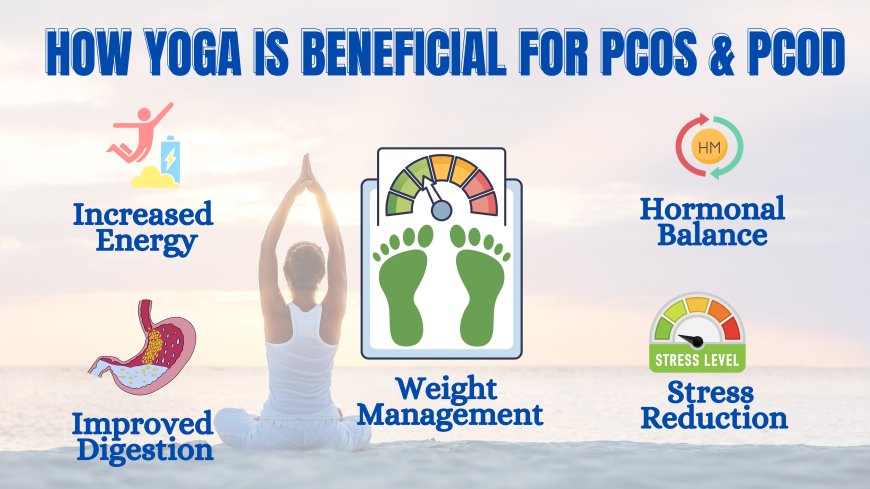Yoga for PCOS and PCOD: Best Poses to Balance Hormones Naturally and and Boost Fertility
Balance hormones and manage PCOS naturally with yoga. Discover the best poses to regulate periods, boost fertility, and improve overall well-being.

Polycystic Ovary Syndrome (PCOS) and Polycystic Ovarian Disease (PCOD) are common hormonal disorders that affect women of reproductive age. These conditions often lead to symptoms such as irregular periods, weight gain, acne, hair loss, and infertility, making them challenging to manage.
One of the most effective and natural ways to alleviate PCOS and PCOD symptoms is yoga. Practicing yoga regularly helps regulate hormones, reduce stress, improve insulin sensitivity, and promote overall well-being. In this article, we will explore the best yoga poses for PCOS and how they can help balance your body naturally.
Yoga is a holistic practice that can significantly help manage PCOS and PCOD by:
-
Balancing hormones by reducing excess androgens and regulating estrogen levels.
-
Improving insulin sensitivity, which helps control blood sugar and weight.
-
Reducing stress and anxiety by lowering cortisol levels.
-
Boosting blood circulation, improving oxygen supply to reproductive organs.
-
Regulating menstrual cycles and enhancing ovarian function.

1. Butterfly Pose (Baddha Konasana)
Benefits:
-
Improves blood circulation in the pelvic region.
-
Stimulates ovaries and regulates menstrual cycles.
-
Reduces stress and enhances flexibility.
How to Do It:
-
Sit with your spine straight and bring the soles of your feet together.
-
Hold your feet with your hands and gently flap your knees up and down.
-
Keep breathing deeply and continue for 1-2 minutes.
Benefits:
-
Strengthens the lower back and abdomen.
-
Stimulates ovarian function and reduces PCOS symptoms.
-
Opens up the chest, improving oxygen supply.
How to Do It:
-
Lie on your stomach with your legs extended.
-
Place your palms near your shoulders and lift your upper body while inhaling.
-
Hold for 10-15 seconds and release slowly.
Benefits:
-
Improves reproductive health and stimulates hormone production.
-
Helps reduce menstrual discomfort.
-
Strengthens abdominal organs and boosts digestion.
How to Do It:
-
Lie on your stomach and bend your knees.
-
Grab your ankles and lift your chest while pulling your legs upward.
-
Hold for 15-20 seconds, then release.
Benefits:
-
Increases blood flow to reproductive organs.
-
Enhances spinal flexibility and relieves stress.
-
Promotes hormone balance by stimulating the adrenal glands.
How to Do It:
-
Start in a tabletop position with hands and knees on the floor.
-
Inhale, arch your back (Cow Pose), lifting your tailbone and looking up.
-
Exhale, round your spine (Cat Pose), tucking your chin toward your chest.
-
Repeat for 1-2 minutes.
Benefits:
-
Reduces stress and promotes relaxation.
-
Stimulates blood circulation to the pelvic area.
-
Relieves lower back pain and menstrual discomfort.
How to Do It:
-
Kneel on the floor, sit back on your heels, and extend your arms forward.
-
Rest your forehead on the mat and relax for 30 seconds to 1 minute.
Benefits:
-
Opens up the pelvic region and improves ovarian function.
-
Helps regulate menstrual cycles.
-
Reduces bloating and stress.
How to Do It:
-
Lie on your back and bring the soles of your feet together.
-
Let your knees drop outward and rest your hands by your sides.
-
Breathe deeply and relax for 1-2 minutes.
Benefits:
-
Lowers stress hormones like cortisol, which worsens PCOS symptoms.
-
Improves oxygen supply and detoxifies the body.
-
Enhances concentration and emotional well-being.
Best Pranayama Techniques:
-
Nadi Shodhana (Alternate Nostril Breathing) – Balances hormones and reduces anxiety.
-
Bhramari (Humming Bee Breath) – Helps relieve stress and improve focus.
-
Kapalabhati (Skull Shining Breath) – Boosts metabolism and reduces weight.
 Additional Tips for Managing PCOS with Yoga
Additional Tips for Managing PCOS with Yoga
-
Practice yoga daily for consistent hormone balance.
-
Combine yoga with a healthy diet rich in fiber and protein.
-
Stay hydrated by drinking plenty of water and herbal teas.
-
Manage stress with meditation, journaling, and deep breathing exercises.
-
Avoid overexertion, as intense workouts may stress the body further.
Yoga is a powerful tool to manage PCOS and PCOD naturally. Regular practice of these yoga poses and breathing exercises can help balance hormones, regulate periods, and improve overall well-being. Along with yoga, maintaining a healthy diet, reducing stress, and staying active can significantly improve symptoms.
If you have PCOS or PCOD, start incorporating these yoga poses into your daily routine and experience the transformative benefits for your health and fertility.
Take charge of your well-being with yoga!
What's Your Reaction?
 Like
0
Like
0
 Dislike
0
Dislike
0
 Love
0
Love
0
 Funny
0
Funny
0
 Angry
0
Angry
0
 Sad
0
Sad
0
 Wow
0
Wow
0























